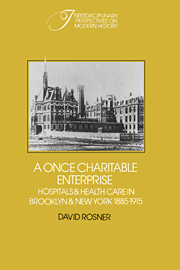Book contents
- Frontmatter
- Contents
- Preface
- Introduction
- 1 Health care and community change
- 2 Embattled benefactors: the crisis in hospital financing
- 3 Social class and hospital care
- 4 Conflict in the new hospital
- 5 Taking control: political reform and hospital governance
- 6 Consolidating control over the small dispensary: the doctors, the city, and the state
- 7 The battle for Morningside Heights: power and politics in the boardroom of New York Hospital
- 8 Looking backward
- Notes on sources
- Notes
- Select bibliography
- Index
7 - The battle for Morningside Heights: power and politics in the boardroom of New York Hospital
Published online by Cambridge University Press: 07 October 2009
- Frontmatter
- Contents
- Preface
- Introduction
- 1 Health care and community change
- 2 Embattled benefactors: the crisis in hospital financing
- 3 Social class and hospital care
- 4 Conflict in the new hospital
- 5 Taking control: political reform and hospital governance
- 6 Consolidating control over the small dispensary: the doctors, the city, and the state
- 7 The battle for Morningside Heights: power and politics in the boardroom of New York Hospital
- 8 Looking backward
- Notes on sources
- Notes
- Select bibliography
- Index
Summary
New York and Brooklyn community hospitals and dispensaries were organized and run by local church groups, merchants, and other organizations and leaders. These sponsors lent to their institutions the ethnic or religious flavor that made the services unique. Rarely, if ever, were the trustees and governors important on the regional, state, or national level. When the forces of industrial and economic change, commercial development, or demographic reorganization and political upheaval altered the relationships and neighborhoods in which these institutions were located, the hospitals found themselves subjected to pressures well beyond their control. In the face of these growing pressures, smaller institutions sometimes moved away or reorganized, or perhaps went out of existence.
For some Manhattan hospitals, the story was different. Some hospitals were larger, had more political power, and were more secure financially. Their lay governors and trustees often came from older and more prominent New York families who controlled and owned significant portions of the city and provided access to benefactors, legacies, and landholdings. Given the enormous financial and political resources of these institutions and their trustees, it is not surprising to find that when they came into conflict with the forces of urbanization and capitalist development that seriously disrupted smaller facilities, the outcomes were substantially different. Although larger hospitals and institutions were often pressured to move by realtors, they generally had more control over where they moved and how they affected neighborhoods than did community hospitals.
- Type
- Chapter
- Information
- A Once Charitable EnterpriseHospitals and Health Care in Brooklyn and New York 1885–1915, pp. 164 - 186Publisher: Cambridge University PressPrint publication year: 1982

